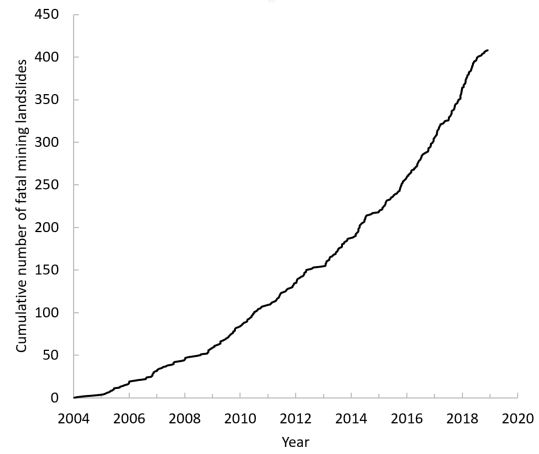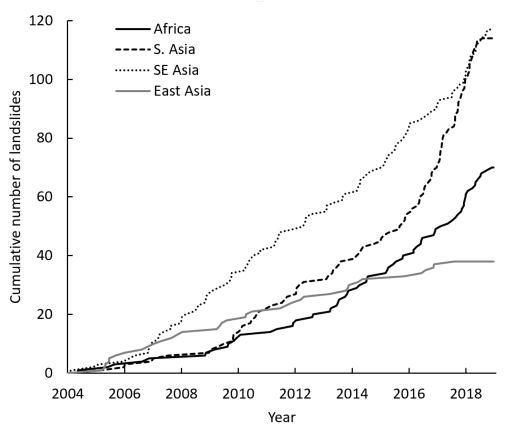2 December 2019
Losses from mining-related landslides
Posted by Dave Petley
Losses from mining-related landslides
Next Tuesday I will deliver a lecture in Hong Kong that focuses on mining-related landslides. In the latest of my sequence of papers on global losses from landslides, published last year with my then post-doctoral researcher Melanie Froude, we highlighted the increasing levels of global loss from mining and quarrying related landslides. In preparing for the lecture in Hong Kong I have been revisiting the data.
The graph below shows the cumulative total number of mining-related landslides from the start of 2004 to the end of 2018, as recorded in my dataset:-

The cumulative total number of mining-related landslides from 2003 to 2018 inclusive.
.
The data clear shows an increasing trend through time. This is a complex pattern, and we need to be careful in interpreting the data. For example, it does appear that the number of mining-related landslides that I recorded in the first year might have been anomalously low – perhaps through 2004 I was still learning how to collect the data. But since then the graph has steepened with time, and by the end of 2018 I had recorded 408 mining-related landslides, causing almost 2,800 deaths.
It is really interesting to try to understand what is driving this change. One way to get at this is to look at the data in terms of location. The sad reality is that the vast majority of fatal mining-related landslides occur outside of Europe, North America and Australia/New Zealand. This reflects the dramatic effects of mining regulation – in areas where mining is managed properly landslides are less common, and are far less likely to kill large numbers of people.
The graph below breaks the data for mining-related landslides into four geographical areas:-

The cumulative total number of mining-related landslides from 2003 to 2018 inclusive, broken down according to four main geographical areas.
.
The trends are really interesting. In SE. Asia large numbers of mining-related landslides occur, but the rate is essentially constant with time. East Asia suffers rather less (although I am increasingly concerned as to whether we are really capturing the true extent of these accidents in China). Thus, t significant global increases are driven by changes in Africa and in particular in South Asia, both of which have seen a dramatic rise since about 2010.
I can only speculate on what has driven this change. Of course it is possible that I have simply become better at capturing these events, although that seems unlikely. It is more likely that the accelerating demand for resources in these poorer parts of the world over the last decade has driven an increase in unsafe mining activities, resulting in higher numbers of landslides. In Africa and South Asia in particular, mining can be very poorly regulated.
The vast majority of these losses are avoidable. We know how to manage slopes around mines to minimise risk.


 Dave Petley is the Vice-Chancellor of the University of Hull in the United Kingdom. His blog provides commentary and analysis of landslide events occurring worldwide, including the landslides themselves, latest research, and conferences and meetings.
Dave Petley is the Vice-Chancellor of the University of Hull in the United Kingdom. His blog provides commentary and analysis of landslide events occurring worldwide, including the landslides themselves, latest research, and conferences and meetings.
Very interesting work and some terrible losses of life in particular in both legal and illegal mining. I remember reading the paper last year and also seeing the seasonal (rainfall-triggering) effects too. All the data sets seem to start at 2004 – I wonder how the data would look if we had a magic historic insight into global landslides in the pre-internet age, and what longer-term temporal trends would be evident? Is the situation improving, say, over the last century, measured on a per 1000 workers basis?
Your last line in intriguing (“The vast majority of these losses are avoidable. We know how to manage slopes around mines to minimise risk.”). In part, yes. A registered mining company has no interest in increased Lost Time Injury Frequency Rates (LTIFR) or pit closure halting extraction, although sometimes, production pressures occur and mining conditions can be unanticipated. Nevertheless, how can illegal mining activities be made safer….? Perhaps a focus needs to be on social and economic development policies in those illegal mining areas, so that people do not have to risk their lives in problematic open cuts in order to provide for their families.